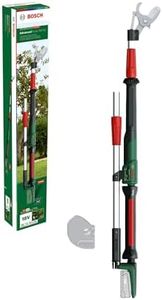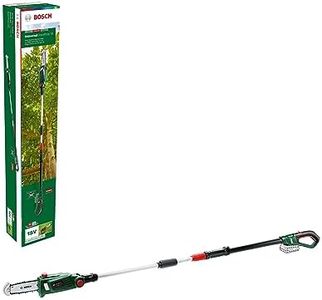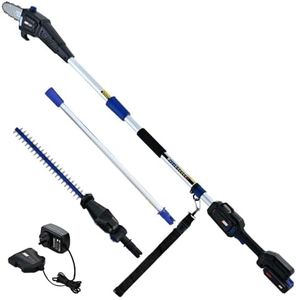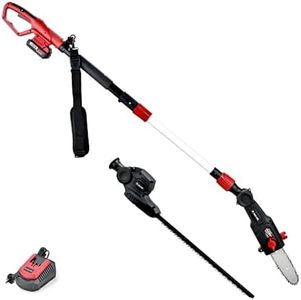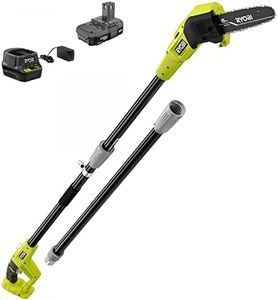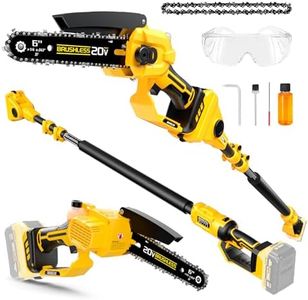We Use CookiesWe use cookies to enhance the security, performance,
functionality and for analytical and promotional activities. By continuing to browse this site you
are agreeing to our privacy policy
10 Best Battery Powered Pole Saws
From leading brands and best sellers available on the web.Recommended lists
Buying Guide for the Best Battery Powered Pole Saws
Choosing the right battery-powered pole saw can make tasks like pruning trees and maintaining your yard much easier and safer. When shopping for one, it's important to assess your needs and match them with the tool's capabilities. Consider how often you’ll use the saw, the types and thicknesses of branches you’ll cut, and how comfortable you are with handling outdoor power equipment. Understanding the essential features will help ensure you pick a model that fits your specific requirements, making your gardening both enjoyable and efficient.Battery Voltage (V)Battery voltage is a measure of the power output available from the battery, and it directly affects the saw's cutting performance. Higher voltage batteries generally provide more force, allowing the saw to cut through thicker, tougher branches with greater ease. Pole saws typically come in a range of voltages, such as 20V, 40V, or even 60V. If you need a saw for occasional, light-duty work on smaller branches, a lower voltage can suffice and may be lighter to handle. For frequent use or tackling thicker, hardwood branches, higher voltage offers a more robust option. Your expected workload should guide your choice here—pick a voltage that matches the typical size and density of branches you need to cut.
Bar LengthThe bar length refers to the cutting length of the pole saw—the part of the saw blade that actually does the work. Shorter bars, typically around 6 to 8 inches, are best for smaller, thinner branches and provide better control. Longer bars, up to 10 or 12 inches, allow you to cut through larger branches but can be heavier and slightly harder to maneuver. Consider the types and thickness of branches you'll most often prune; if you're mainly doing light, routine trimming, a shorter bar may be ideal. For occasional heavy-duty cutting, opt for a longer bar for greater reach and capacity.
Pole Length (Reach)Pole length determines how high you can reach with the saw, usually measured as the total length from the base to the tip. Some pole saws offer adjustable or extendable poles, making it easy to change the length for different tasks. Shorter poles of 6-8 feet are lighter and easier to manage but may not reach the highest branches. Longer poles, sometimes extending up to 14 feet or more, help you reach tall, overhead limbs without needing a ladder. Think about the height of trees in your yard: regular low pruning needs only a short pole, while mature or taller trees may require the maximum reach.
Battery RuntimeBattery runtime indicates how long you can use the pole saw between charges, usually given in minutes. Shorter runtimes may be adequate for quick jobs or small yards, while longer runtimes are necessary for extended sessions or larger properties. If your work often takes over 30 minutes, look for a battery with higher amp-hour (Ah) ratings or consider models with extra/replaceable batteries. Match your typical work session time with the runtime, ensuring you don’t run out of power mid-task.
WeightThe weight of a pole saw affects your ability to use it comfortably, especially for extended periods or at arm’s length above your head. Lighter saws are easier to handle, reduce fatigue, and provide better control, but they may sacrifice some power or capacity. Heavier saws generally offer more robust construction and bigger batteries for longer use but may be tiring for some users. Consider your physical comfort and strength—if you plan to use the saw often or for long stretches, a lightweight model could be the better fit for you.
Chain Tensioning SystemThe chain tensioning system is how you adjust the tightness of the saw chain, which is necessary for safe, efficient cutting. Some models offer tool-free tensioning, making adjustments quick and easy without extra tools, while others require a screwdriver or wrench. If you’re new to pole saws or value convenience, a tool-free system can simplify maintenance. For those who don’t mind an extra step and prioritize durability, a tool-based system may also be considered.
Safety FeaturesSafety features are designed to protect you while using the pole saw and may include protective guards, automatic shut-off, or anti-kickback features. These aspects help minimize the risk of injury, especially if you aren’t experienced with power tools. Look for pole saws that offer clear, useful safety mechanisms. If you’re a first-time user or plan to lend the tool to others, robust safety features should be a top priority in your selection process.
